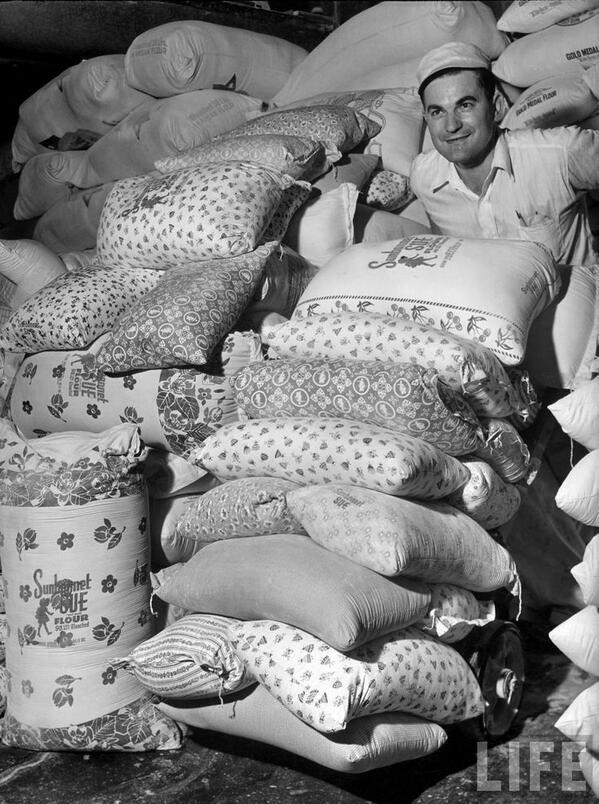| Students attending the school where Mr. Goertzen taught. |
However, many farm families noticed the sacks in which the feed grains for farm animals arrived, while women in more urbanized settings were noticing the canvas bags in which flour came. Using a bit of ingenuity and sewing skills, many women remade these bags into clothing items for their broods of children. Norma Ehlers, who was a child back then, doesn't remember ever getting a "store-bought dress" until she reached high school.
Eventually the companies that milled flour and provided feed noticed that the women were using the bags to make clothing. That's when they started to use various designs for the sacks, including flower designs. Not only did women make clothing, but they also made other needed items from the fabric, including dish towels, washcloths, and diapers. The trend caught on, so as time went by, more and more designs were utilized to make the sacks. The designs became so diverse that if you happened to buy a sack one week with a particular design and liked it so much you wanted to get the same design and you went back to the store to find it, you never found that same design again.
Have you ever looked at any group photos of the time period, say for instance, class photographs? Notice that there is a similarity in the fabric design of the clothing. Herman Goertzen, a teacher at the time, noticed, "Well, the chicken feed usually came in a patterned material, and the ladies liked to sew at the time." Since most clothes were homemade, he said, "the patterns came from chicken seed sacks, flour sacks I believe. Flour sacks came from the same item. They wanted to sell flour, and if the ladies would like to put patterns on the sacks, sure, that would be the incentive to buy more feed, and it was always probably hard to get the next pattern. The next time you went in to buy a sack of feed, you couldn't get the same pattern." Millie Opitz, who was a student of Mr. Goertzen, recalled that people had to recycle the sacks, "Cause, Lord, we didn't have no money to spend or nothing."
By the time that World War II came to dominate everyone's lives, in the 1940's, more than three million women and children were wearing homemade clothes from feed sacks. Even into World War II, fabrics remained at a premium because they were designated to be used for military uniforms. Many feed companies would provide instructions for how to remove the ink.
By the 1950's society had changed to the point that people were drawn more to store-bought clothing. Manufacturers started using paper-based sacks, so the trend ended. You could actually buy reams of fabric in whatever pattern suited for your projects, if you continued to make clothing. It's something my mother did when I was a child. We could pick patterns from bolts of fabric and clothing patterns from those that were available commercially. My mother made some homemade clothing, usually for special occasions, like graduation, first Communion, Confirmation. But even with my mother's skills, we turned more to manufactured clothing; it was easier.
| Dresses made from feed sacks hang on a clothes line. |
 |
| Some of the different patterns used for flour sacks. |
No comments:
Post a Comment